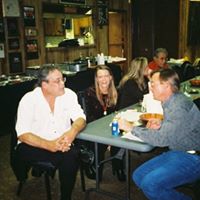Phillip L Sharp
age ~72
from Arverne, NY
- Also known as:
-
- Phillip Linda Sharp
- Philip Sharp
- Phil Sharp
- Linda Sharp
- Phillip Sharpe
Phillip Sharp Phones & Addresses
- Arverne, NY
- Jamaica, NY
- 3302 Mill Race Rd, N Chesterfld, VA 23234 • 8043498996
- North Chesterfield, VA
- Brooklyn, NY
- 35 Lewis St, Freeport, NY 11520 • 5163775790
- Nashville, AR
- Houston, TX
Work
-
Company:Davis Polk & Wardwell LLP
-
Address:
Education
-
School / High School:Queensland University of Technology
Ranks
-
Licence:New York - Currently registered
-
Date:2009
Resumes

Phillip Sharp
view sourceLocation:
Jamaica, NY
Industry:
Music
Work:
Sears Home Improvement Products 2011 - 2013
Sales Project Consultant
Sales Project Consultant

Phillip Sharp
view source
Phillip Sharp
view source
Phillip Sharp
view sourceLocation:
United States
Lawyers & Attorneys

Phillip Gordon Sharp - Lawyer
view sourceAddress:
Davis Polk & Wardwell LLP
Licenses:
New York - Currently registered 2009
Education:
Queensland University of Technology

Phillip Sharp - Lawyer
view sourceOffice:
Davis Polk & Wardwell LLP
ISLN:
921034528
Admitted:
2009
University:
Queensland University of Technology Brisbane, Australia, B.A., 2000
Law School:
Oxford University, England, B.C.L., 2007
Wikipedia

Phillip Allen Sharp
view sourcePhillip Allen Sharp (born June 6, 1944) is an American geneticist and molecular biologist who co-discovered RNA splicing. He shared the 1993 Nobel Prize in ...
Us Patents
-
Nuclear Factors Associated With Transcriptional Regulation
view source -
US Patent:6410516, Jun 25, 2002
-
Filed:Jun 5, 1995
-
Appl. No.:08/464364
-
Inventors:David Baltimore - New York NY
Ranjan Sen - Cambridge MA
Phillip A. Sharp - Newton MA
Harinder Singh - Chicago IL
Louis Staudt - Silver Springs MD
Jonathan H. Lebowitz - Zionsville IN
Roger G. Clerc - Binningen, CH
Lynn M. Corcoran - Port Melbourne, AU
Patrick A. Baeuerle - Eichenau, DE
Michael J. Lenardo - Potomac MD
Chen-Ming Fan - San Francisco MA
Thomas P. Maniatis - Belmont MA -
Assignee:President Fellows of Harvard College - Cambridge MA
Massachusetts Institute of Technology - Cambridge MA
Whitehead Instittue for Biomedical Research - Cambridge MA -
International Classification:A61K 31711
-
US Classification:514 44, 435 6, 435455, 435325, 435366, 435370, 435372, 4353722, 4353723
-
Abstract:Constitutive and tissue-specific protein factors which bind to transcriptional regulatory elements of Ig genes (promoter and enhancer) are described. The factors were identified and isolated by an improved assay for protein-DNA binding. Genes encoding factors which positively regulate transcription can be isolated and employed to enhance transription of Ig genes. In particular, NF-kB, the gene encoding NF-kB, IkB and the gene encoding IkB and uses therefor.
-
Nuclear Factors Associated With Transcriptional Regulation
view source -
US Patent:20040214757, Oct 28, 2004
-
Filed:Jan 4, 2002
-
Appl. No.:10/037341
-
Inventors:David Baltimore - New York NY, US
Ranjan Sen - Cambridge MA, US
Phillip Sharp - Newton MA, US
Harinder Singh - Chicago IL, US
Louis Staudt - Silver Springs MD, US
Jonathan LeBowitz - Zionsville IN, US
Albert Baldwin - Chapel Hill NC, US
Roger Clerc - Binningen, CH
Lynn Corcoran - Port Melbourne, AU
Patrick Baeuerle - Eichenau, DE
Michael Lenardo - Potomac MD, US
Chen-Ming Fan - San Francisco MA, US
Thomas Maniatis - Belmont MA, US -
International Classification:C07K014/47
C07H021/04 -
US Classification:514/012000, 530/358000, 536/023500
-
Abstract:Constitutive and tissue-specific protein factors which bind to transcriptional regulatory elements of Ig genes (promoter and enhancer) are described. The factors were identified and isolated by an improved assay for protein-DNA binding. Genes encoding factors which positively regulate transcription can be isolated and employed to enhance transcription of Ig genes. In particular, NF-kB, the gene encoding NF-kB, IkB and the gene encoding IkB and uses therefor.
-
Nuclear Factors Associated With Transcriptional Regulation
view source -
US Patent:20060063709, Mar 23, 2006
-
Filed:Jan 4, 2002
-
Appl. No.:10/037415
-
Inventors:David Baltimore - New York NY, US
Ranjan Sen - Cambridge MA, US
Phillip Sharp - Newton MA, US
Harinder Singh - Chicago IL, US
Louis Staudt - Silver Springs MD, US
Jonathan LeBowitz - Zionsville, IN
Albert Baldwin - Chapel Hill NC, US
Roger Clerc - Binningen, CH
Lynn Corcoran - Port Melbourne, AU
Patrick Baeuerle - Eichenau, DE
Michael Lenardo - Potomac MD, US
Chen-Ming Fan - San Francisco CA, US
Thomas Maniatis - Belmont CA, US -
International Classification:A61K 38/17
C07K 14/47
C07H 21/04 -
US Classification:514012000, 530358000, 536023500
-
Abstract:Constitutive and tissue-specific protein factors which bind to transcriptional regulatory elements of Ig genes (promoter and enhancer) are described. The factors were identified and isolated by an improved assay for protein-DNA binding. Genes encoding factors which positively regulate transcription can be isolated and employed to enhance transcription of Ig genes. In particular, NF-kB, the gene encoding NF-kB, IkB and the gene encoding IkB and uses therefor.
-
Rna Sequence-Specific Mediators Of Rna Interference
view source -
US Patent:20070003960, Jan 4, 2007
-
Filed:Jun 26, 2006
-
Appl. No.:11/474738
-
Inventors:Thomas Tuschl - New York NY, US
Phillip Zamore - Northborough MA, US
Phillip Sharp - Newton MA, US
David Bartel - Brookline MA, US -
Assignee:Whitehead Institute for Biomedical Research - Cambridge MA
Massachusetts Institute of Technology - Cambridge MA
University of Massachusetts Medical Center - Worcester MA
Max-Planck-Gesellschaft zur Forderug der Wissenschaften E.V. - Munich -
International Classification:C12Q 1/68
A01K 67/033
C12N 1/21
C12N 5/06 -
US Classification:435006000, 435325000, 435252300, 800008000
-
Abstract:The present invention relates to a in vitro system which was used to demonstrate that dsRNA is processed to RNA segments 21-23 nucleotides (nt) in length. Furthermore, when these 21-23 nt fragments are purified and added back to extracts, they mediate RNA interference in the absence of long dsRNA. Thus, these 21-23 nt fragments are the sequence-specific mediators of RNA degradation. A molecular signal, which may be their specific length, must be present in these 21-23 nt fragments to recruit cellular factors involved in RNAi. This present invention encompasses these 21-23 nt fragments and their use for specifically inactivating gene function. The use of these fragments (or chemically synthesized oligonucleotides of the same or similar nature) enables the targeting of specific mRNAs for degradation in mammalian cells, where the use of long dsRNAs to elicit RNAi is usually not practical, presumably because of the deleterious effects of the interferon response. This specific targeting of a particular gene function is useful in functional genomic and therapeutic applications.
-
Rna Sequence-Specific Mediators Of Rna Interference
view source -
US Patent:20070003961, Jan 4, 2007
-
Filed:Jun 26, 2006
-
Appl. No.:11/474919
-
Inventors:Thomas Tuschl - New York NY, US
Phillip Zamore - Northborough MA, US
Phillip Sharp - Newton MA, US
David Bartel - Brookline MA, US -
Assignee:Whitehead Institute for Biomedical Research - Cambridge MA
Massachusetts Institute of Technology - Cambridge MA
University of Massachusetts Medical Center - Worcester MA
Max-Planck-Gesellschaft zur Forderug der Wissenschaften E.V. - Munich -
International Classification:C12Q 1/68
-
US Classification:435006000
-
Abstract:The present invention relates to a in vitro system which was used to demonstrate that dsRNA is processed to RNA segments 21-23 nucleotides (nt) in length. Furthermore, when these 21-23 nt fragments are purified and added back to extracts, they mediate RNA interference in the absence of long dsRNA. Thus, these 21-23 nt fragments are the sequence-specific mediators of RNA degradation. A molecular signal, which may be their specific length, must be present in these 21-23 nt fragments to recruit cellular factors involved in RNAi. This present invention encompasses these 21-23 nt fragments and their use for specifically inactivating gene function. The use of these fragments (or chemically synthesized oligonucleotides of the same or similar nature) enables the targeting of specific mRNAs for degradation in mammalian cells, where the use of long dsRNAs to elicit RNAi is usually not practical, presumably because of the deleterious effects of the interferon response. This specific targeting of a particular gene function is useful in functional genomic and therapeutic applications.
-
Rna Sequence-Specific Mediators Of Rna Interference
view source -
US Patent:20070003962, Jan 4, 2007
-
Filed:Jun 26, 2006
-
Appl. No.:11/474930
-
Inventors:Thomas Tuschl - New York NY, US
Phillip Zamore - Northborough MA, US
Phillip Sharp - Newton MA, US
David Bartel - Brookline MA, US -
Assignee:Whitehead Institute for Biomedical Research - Cambridge MA
Massachusetts Institute of Technology - Cambridge MA
University of Massachusetts Medical Center - Worcester MA
Max-Planck-Gesellschaft zur Forderug der Wissenschaften E. V. - Munich -
International Classification:C12Q 1/68
C07H 21/02
C12P 19/34 -
US Classification:435006000, 435091200, 536023100
-
Abstract:The present invention relates to a Drosophila in vitro system which was used to demonstrate that dsRNA is processed to RNA segments 21-23 nucleotides (nt) in length. Furthermore, when these 21-23 nt fragments are purified and added back to Drosophila extracts, they mediate RNA interference in the absence of long dsRNA. Thus, these 21-23 nt fragments are the sequence-specific mediators of RNA degradation. A molecular signal, which may be their specific length, must be present in these 21-23 nt fragments to recruit cellular factors involved in RNAi. This present invention encompasses these 21-23 nt fragments and their use for specifically inactivating gene function. The use of these fragments (or chemically synthesized oligonucleotides of the same or similar nature) enables the targeting of specific mRNAs for degradation in mammalian cells, where the use of long dsRNAs to elicit RNAi is usually not practical, presumably because of the deleterious effects of the interferon response. This specific targeting of a particular gene function is useful in functional genomic and therapeutic applications.
-
Rna Sequence-Specific Mediators Of Rna Interference
view source -
US Patent:20070003963, Jan 4, 2007
-
Filed:Jun 26, 2006
-
Appl. No.:11/474932
-
Inventors:Thomas Tuschl - New York NY, US
Phillip Zamore - Northborough MA, US
Phillip Sharp - Newton MA, US
David Bartel - Brookline MA, US -
Assignee:Whitehead Institute for Biomedical Research - Cambridge MA
Massachusetts Institute of Technology - Cambridge MA
University of Massachusetts Medical Center - Worcester MA
Max-Planck-Gesellschaft zur Forderug der Wissenschaften E.V. - Munich -
International Classification:C12Q 1/68
C12N 15/86 -
US Classification:435006000, 435456000
-
Abstract:The present invention relates to a Drosophila in vitro system which was used to demonstrate that dsRNA is processed to RNA segments 21-23 nucleotides (nt) in length. Furthermore, when these 21-23 nt fragments are purified and added back to Drosophila extracts, they mediate RNA interference in the absence of long dsRNA. Thus, these 21-23 nt fragments are the sequence-specific mediators of RNA degradation. A molecular signal, which may be their specific length, must be present in these 21-23 nt fragments to recruit cellular factors involved in RNAi. This present invention encompasses these 21-23 nt fragments and their use for specifically inactivating gene finction. The use of these fragments (or chemically synthesized oligonucleotides of the same or similar nature) enables the targeting of specific mRNAs for degradation in mammalian cells, where the use of long dsRNAs to elicit RNAi is usually not practical, presumably because of the deleterious effects of the interferon response. This specific targeting of a particular gene function is useful in functional genomic and therapeutic applications.
-
Rna Sequence-Specific Mediators Of Rna Interference
view source -
US Patent:20080132461, Jun 5, 2008
-
Filed:Jul 19, 2007
-
Appl. No.:11/880464
-
Inventors:Thomas Tuschi - New York NY, US
Phillip D. Zamore - Northborough MA, US
Phillip A. Sharp - Newton MA, US
David P. Bartel - Brookline MA, US -
Assignee:Whitehead Institute for Biomedical Research - Cambridge MA
Massachusetts Institute of Technology - Cambridge MA
University of Massachusetts Medical Center - Worcester MA
Max-Planck-Gesellschaft zur Forderung der - Munich -
International Classification:A61K 31/70
C12N 15/87
A61P 43/00
C12N 15/01 -
US Classification:514 44, 435463, 435441
-
Abstract:The present invention relates to a Drosophila in vitro system which was used to demonstrate that dsRNA is processed to RNA segments 21-23 nucleotides (nt) in length. Furthermore, when these 21-23 nt fragments are purified and added back to Drosophila extracts, they mediate RNA interference in the absence of long dsRNA. Thus, these 21-23 nt fragments are the sequence-specific mediators of RNA degradation. A molecular signal, which may be their specific length, must be present in these 21-23 nt fragments to recruit cellular factors involved in RNAi. This present invention encompasses these 21-23 nt fragments and their use for specifically inactivating gene function. The use of these fragments (or chemically synthesized oligonucleotides of the same or similar nature) enables the targeting of specific mRNAs for degradation in mammalian cells, where the use of long dsRNAs to elicit RNAi is usually not practical, presumably because of the deleterious effects of the interferon response. This specific targeting of a particular gene function is useful in functional genomic and therapeutic applications.
Name / Title
Company / Classification
Phones & Addresses
PHILLIP SHARP LLC
VPJM LTD
Incorporator
GARDNER'S WOCO PEP STATION, INC
Isbn (Books And Publications)


DNA Tumor Viruses: Control of Gene Expression and Replication
view sourceAuthor
Phillip A. Sharp
ISBN #
0879691921
Plaxo

Phillip J Sharps
view sourceLittle Rock, AR
Googleplus

Phillip Sharp

Phillip Sharp

Phillip Sharp

Phillip Sharp

Phillip Sharp

Phillip Sharp
Tagline:
I am a future member of the USMC, I am currently in my last year of high school, but I have completed the USMC boot camp and I do intend to enter my enlistment after college and go in as an officer.
Bragging Rights:
Survived 12 weeks and a Crucible

Phillip Sharp

Phillip Sharp
Classmates

Phillip Sharp
view sourceSchools:
Dublin Scioto High School Dublin OH 1995-1999
Community:
Audrey Danner, Dustin Yost

Phillip Sharp
view sourceSchools:
Lone Oak High School Lone Oak TX 1990-1994
Community:
Shannon Thornton

Phillip Sharp
view sourceSchools:
Faith Academy Manila OR 1975-1979
Community:
Rhonda Miller, Duane Wilhite, Jonathan Payne

Phillip Sharp
view sourceSchools:
Carrollton High School Carrollton TX 1963-1967
Community:
Robert Robert, Sondra Kelly, Joyce Jenkins, Gerald Randles, Kenneth Souther, Dona Gurtler, Donna Nelson, Virgil Blackman, Bobbie Erwin, Dick Rodriguez, Otis Freeman, Viola James

Phillip Sharp
view sourceSchools:
Laverne High School Laverne OK 2005-2009
Community:
Alex Hickman, Ayla Dixon, Chelsey Rolf, Cameron Hulin, Brandy Firth, Wayleen Caswell, Kale Burlingham, Daniela Daniela, Kylee Crocker, Ashley Smith, Patricia Ramriez

Phillip Sharp
view sourceSchools:
Arkoma High School Arkoma OK 1975-1979
Community:
Janet Sidwell, Eddie Mcalister, Don Johnson, Trish Preston

Phillip Sharp
view sourceSchools:
Custer High School Custer City OK 1944-1957
Community:
Jack Fry, June Sauer, Lyle Dobbins, Gail Mccool, Gayle Agan, Danney Lidia, Violet Southwell, Patricia Fortner, Robert Tharp, Mary Evans

Phillip Sharp
view source
Phillip Sharp
view source
Phillip Sharp
view source
Phillip Sharp
view source
Phillip Sharp
view source
Phillip Sharp
view source
Phillip Sharp
view source
Phillip Sharp
view sourceYoutube
News

Boston’s dense health-sciences networks help the city to maintain its lead
view source- Although California has a strong venture-capital presence, too, the big difference for the Boston area is the presence of leading pharmaceutical companies many of which are just a walk from the Massachusetts Institute of Technology (MIT) and Harvard, says Nobel laureate Phillip Sharp, who holds
- Date: Nov 20, 2024
- Category: Your local news
- Source: Google

MIT developing framework for Covid-19 vaccinations on campus
view source- I plan to be vaccinated assoon I can, and I am urgingeveryone at MIT and well beyond to get themselves vaccinated at theirfirst opportunity, says Institute Professor and Nobel laureate Phillip Sharp, whose pioneering research in the 1970s helped pave the way for todays generation of mRNA vacci
- Date: Jan 29, 2021
- Category: More news
- Source: Google

New skeletal disease found and explained
view source- an abnormal expression of several important genes in the cartilaginous growth plates and the ends of the long tubular bones. These studies were done in collaboration with Hiroshi Suzuki, researcher at the Massachusetts Institute of Technology in the lab of Phillip Sharp, Nobel laureate in medicine.
- Date: Feb 25, 2019
- Category: Headlines
- Source: Google

Local scientists worry about NIH's proposed cap on funding for individual labs
view source- point system could penalize work done under multi-institutional NIH grants that involve researchers from multiple labs, often in the Boston area. Science in Massachusetts is done in a collaborative mode where researchers share data and expertise, said Phillip Sharp, a co-founder of Biogen Inc. who
- Date: Jun 07, 2017
- Category: Health
- Source: Google

From basic research to saving lives — the Spinraza story
view source- In the spring of 1977, Drs. Richard Roberts of CSHL and Phillip Sharp, then of MIT, first described RNA splicing a fundamental mechanism in cells that regulates how our genes are expressed, Stillman said.
- Date: Dec 26, 2016
- Category: Health
- Source: Google

107 Nobel laureates sign letter blasting Greenpeace over GMOs
view source- The letter campaign was organized by Richard Roberts, chief scientific officer of New England Biolabs and, with Phillip Sharp, the winner of the 1993 Nobel Prize in physiology or medicine for the discovery of genetic sequences known as introns. The campaign has a website, supportprecisionagriculture
- Date: Jun 29, 2016
- Category: Business
- Source: Google

Cells Read DNA Backward and Forward: Direction is the Key
view source- "This is part of an RNA revolution where we're seeing different RNAs and new RNAs that we hadn't suspected were present in cells, and trying to understand what role they have in the health of the cell or the viability of the cell," said Phillip Sharp, one of the MIT researchers who worked on the stu
- Date: Jun 25, 2013
- Category: Sci/Tech
- Source: Google

Study Elucidates How Cells Make Sense of Transcriptional Direction
view source- MITs Phillip Sharp, Ph.D., and his colleagues this week show that, in murine embryonic stem cells, asymmetric sequence determinants flanking gene transcription start sites control promoter directionality by regulating promoter-proximal cleavage and polyadenylation. Writing in Nature, Dr. Sharps
- Date: Jun 25, 2013
- Category: Sci/Tech
- Source: Google
Get Report for Phillip L Sharp from Arverne, NY, age ~72





